Rohan was asleep when we arrived and awoke when the tent annex was just up and only one bed organised. He cried for a while putting a stop to the setup for at least half an hour. Our site was near the playground, so at least Anja and Lachlan were happy!
The inlet is beautiful with clear blue water and crystal sand. The rocks on the southside of the inlet looked promising for a dive, so having bought ice creams all round we headed out to see it firsthand. The rocks dip vertically making walking on them difficult. The rock platform looked like this in section:

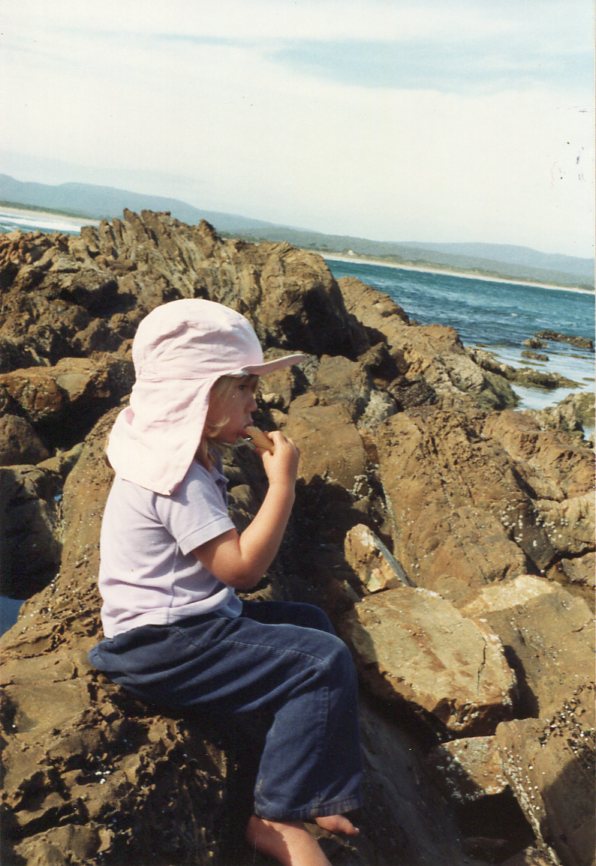
Lachlan slipped and Jacqui - barefooted - managed to get a nasty cut that filled with shell grit as she went to his aid.
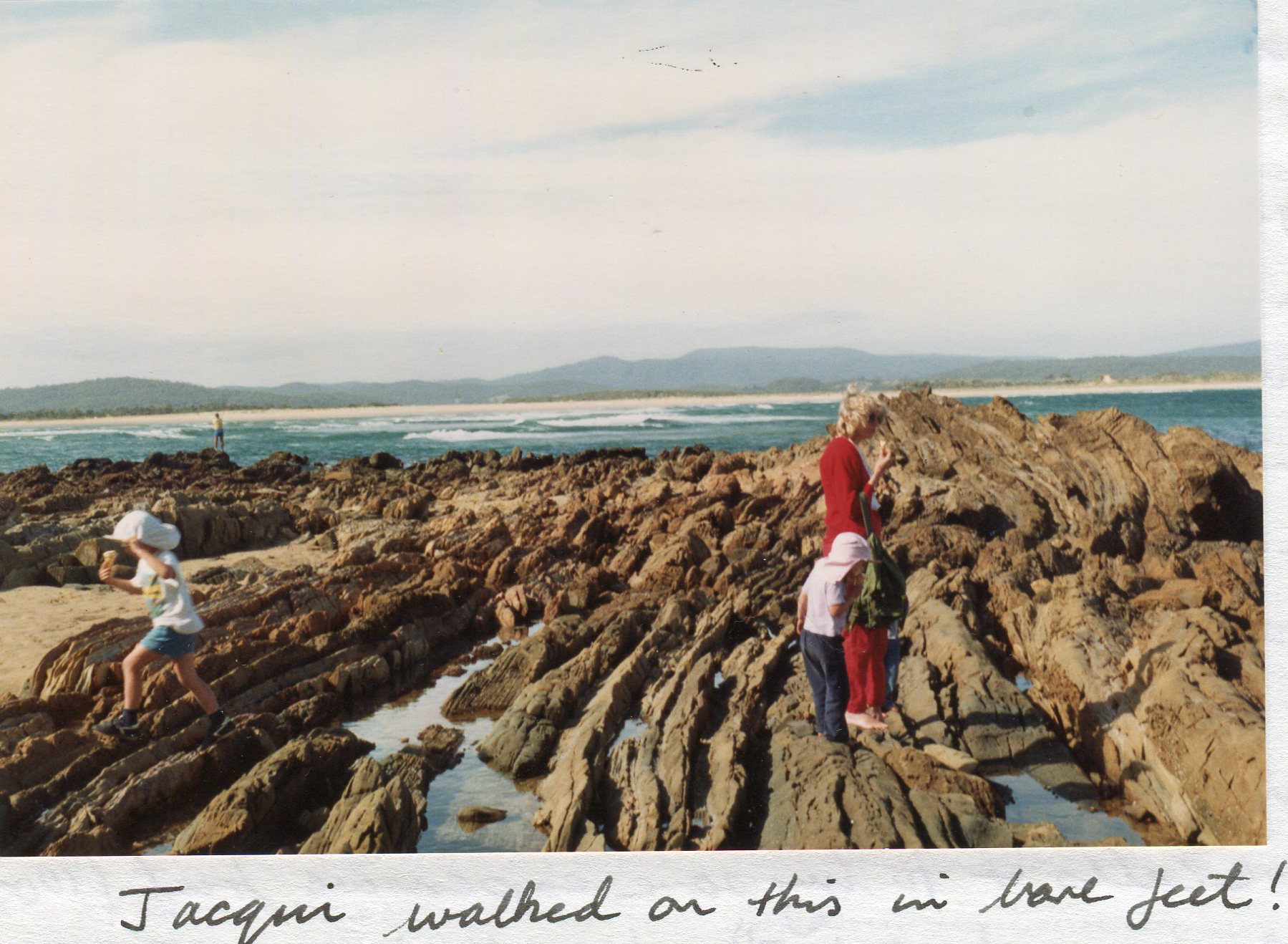
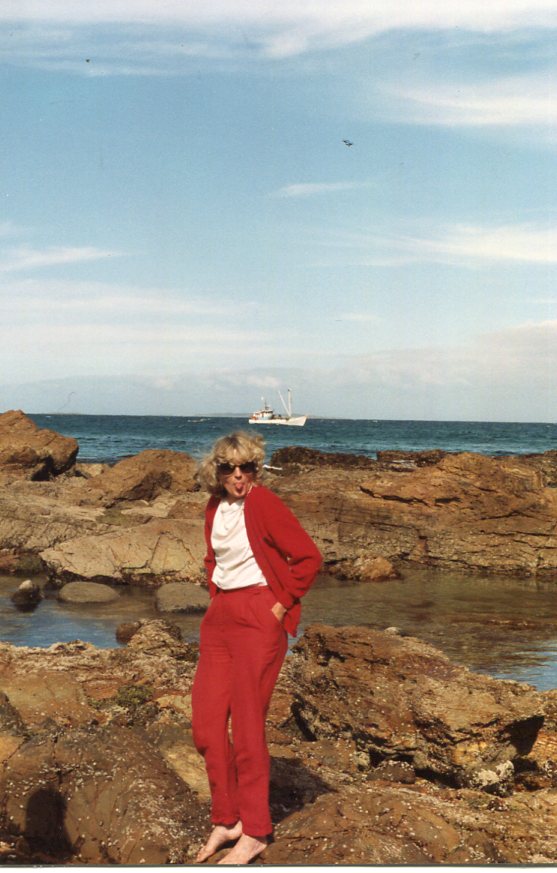
We met a diver coming out of the water and spoke to him about the best places to dive and what type of fish I could expect to see. He was a Kiwi who, with his fiancé, had been travelling around Australia for a year or so. He made some suggestions about travelling through Queensland that look like this:

Twilight is long here and it wasn't until 9:30 PM that the kids stop playing. We had them in bed by 10:15 PM.
By the way, it's cold, with a brisk southerly breeze coming straight off Bass Strait.
Mallacoota is an abalone town. Numerous shark cats [a twin hull boat that is good in rough seas] are parked in front of yards. Each is set up for diving with big coils of yellow air hose visible. One such vessel was called “Ab-Normal”. I found out that there only 40 licenced fisherman who work 50 days per year. With abalone at $80-$90/Kg why work any harder than that?
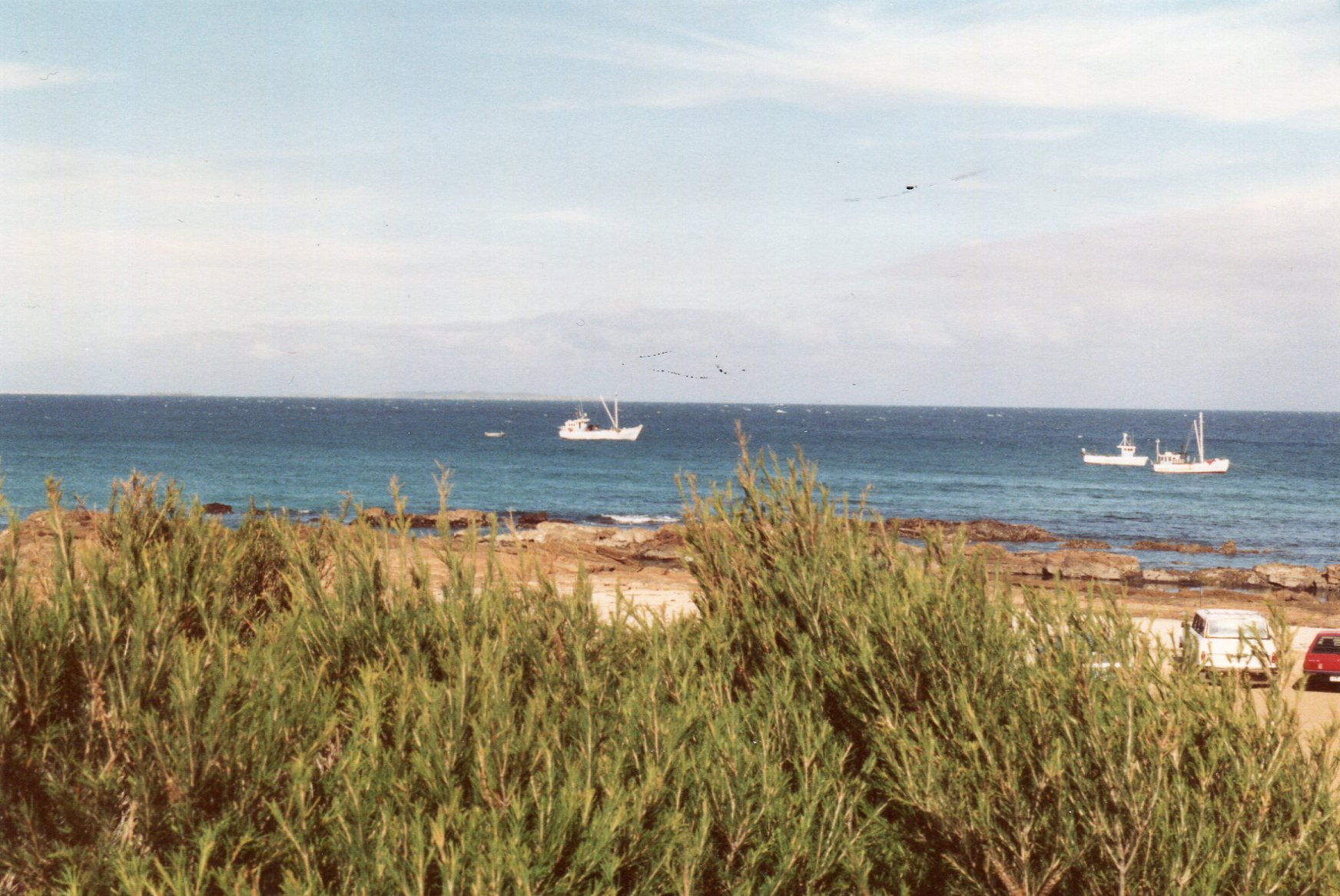 None of the "ab" boats or the fishing boats shown here put to sea because of the gale-force winds. Gabo Is. can be see to the left of the boat in the centre of the photo.
None of the "ab" boats or the fishing boats shown here put to sea because of the gale-force winds. Gabo Is. can be see to the left of the boat in the centre of the photo.
Monday 15th January 1990
I went diving near the boat launching ramp at about 10:00 AM. Getting into the water was no problem but seeing anything was! Visibility was terrible, the water full of sand and shell particles stirred up by the long swell. I shot at and missed a few blackfish, got one small reef fish which I let go and went back to shore. Jacqui notes in the diary that: This dive was highly dangerous. As Ian rounded the point, the wind picked up and hurled the waves against the rocky shoreline. I couldn't get his attention to tell him to go back. Fortunately the poor visibility forced him to return.
We went for a drive on the coast - all rugged headlands and sandy beaches until the road ran out about 5Km after Mallacoota. We stopped in at the local abalone cooperative. They could sell us abalone but at $60/Kg but they suggested the local crays were better value at $22/Kg. The fishing cooperative workers were most surprised to have customers.
Jacqui spent most of the afternoon after lunch washing and I took the kids fishing near the mouth of the inlet. No luck!
Dinner of sausages, a walk to the shop and that was that.
Weather is still cold and overcast. Jacqui was in a cardigan and parker and has been complaining about it nonstop. Warmer weather is forecast. We hope!
Tuesday 16th January 1990
After almost continuous rain overnight I was pleasantly surprised to be greeted by glimpse of clear blue sky through a small opening in the window at the end of my bed. Looks are deceptive however and a big black cloud soon brought another rainstorm.
This was the trend for most of the morning - alternating rain and fine. Kids out playing or inside. During one brief rainy spell the kids and I did a jigsaw puzzle. During one brief sunny spell Lachlan and I played tennis with badminton rackets and a holey plastic ball.
Jacqui had more washing to do - the primary reason we haven't moved on - as she attempts to get things clean from Bournda's black dirt.
That afternoon we drove out of town for a bit of "bush". We started at the Twin Creek nature walk which took us through rainforest and open eucalyptus forest. All in all about 1Km.
Next, we headed down the road towards Genoa and off the main road along 3 kilometres of narrow winding track to Sandy point. This was a small sandy - surprise surprise – point - surprise surprise - on an open area of water. Both Jacqui and I commented on the similarity with Pittwater. The hills were a little lower and less steep, but the comparison was valid. The kids paddled while Jacqui and I huddled together on the point to keep warm. The sun was out but the south-westerly wind was cold.
Back to camp I cooked lasagne in the frying pan. Not too bad even if I do say so myself.
There was a brief scurry of activity when a breathless red-headed teenage girl ran down the path to her parents opposite us saying that the Department of Communication inspectors were here to see all CB licences. Well the aerials came down faster than the spotted gums in a wood chip forest! I even took mine down as I haven't received my licence even though “it's in the post.” The story surfaced later that a cleaner, who had had a fight with some of the campers, may have had S.O.L. and called in the inspectors to get even. Speculation! The inspectors never came to this section of the camp.
I've just switched off the light in the annex and have spent 10 minutes looking at an incredibly clear sky. South from here is over Bass Strait and the Southern Cross, South celestial pole area, and the Magellanic clouds are crystal clear with lots more stars visible than I am used to seeing at home. A great place to take an astronomy class.
Wednesday 17th January 1990
I think we're getting better, if not faster, at packing the van. We seem to have lots of extra space when everything was in and we were ready to go today.
We headed south on the Prince's highway in bright sunshine with a cool breeze blowing. A beautiful day to travel. It would have been perfect on a motorcycle! The highway is a delight, wide, smooth and interesting as it winds through many state forests and national parks. We passed many huge trucks full of wood chips and many tinmber jinkers hauling logs. At present there is a battle between foresters and conservationists as logging is taking place, not only in state forests, but also in national estate areas as well. Jacqui signaled her strong feelings to truck drivers by wagging her fingers as they passed. She wanted to talk to them on the CB radio but I didn't let her as I feared that if the argument got too heated, we might have an unpleasant time with the timber truck: remember the movie Duel?
At Cabbage Tree Creek we turned off on a road to Marlo that was not marked on our map. Even though it was dirt it was well made and smooth. Arriving at Marlo at around 2:00 PM we booked into the caravan park, set up and then went into town to have a look around and get some dinner. "Town" consisted of a general store come service station and a big pub.
Marlo is built where the Snowy River enters the sea. The tidal estuary runs parallel with the beach for several hundred metres before breaking through the low dunes and gaining freedom in Bass Strait.
A frequent visitor we met told us the mouth of the Snowy River can vary from time to time and enter the sea at different places. When we went for a walk along the river's edge, windsurfers were having a great time tacking back and forth across the river propelled by a howling sou-easter. Most had full length wet suits and all wore helmets.
Drama in real life at bedtime! In the middle of a story Lachlan announces he had removed his watch while drinking from a nearby tap. In his rush to get on his bike again he had forgotten it and when we went to look for it, it was gone. Many tears later - about an hour later - Jacqui was in the process of putting up signs and had been to see the manager of the caravan park, when the neighbouring van produced a man who produced his watch. Phew!
Thursday 18th January 1990
It was after 11:00 AM before we got on the road to Cape Conran from our campsite at Marlo. The road is wide, straight, and well made and after only 15 minutes we had covered the 19 kilometres to the Cape. Views of the ocean along the way suggested it would be an excellent day for diving and the scene from the car park confirmed the expectations.
We could park almost at the water’s edge where relatively smooth granite boulders tumbled out into the still, cool, green water. Judging by the number of flathead carcasses around the rocks here was a popular fish cleaning spot for the boating fraternity as they could also launch and recover their runabouts.
Slipping into the water was no problem and before long I spotted a big stingray surprisingly close to shore. The swim out through the forest of kelp growing in profusion amongst the granite boulders was easy in the calm waters.
My first fish was a big coral trout and within an hour I had three red mowong as well. Jacqui was happy too, as I could stay close to the shore and was easily visible for the whole time.
Cleaning the fish near the water’s edge we spotted four other divers shucking abalone and cleaning an excellent bag of red mowong, leather jackets and luderick (that’s what they call blackfish in Vic). When questioned one of them tried to put us off by saying they had found them in a direction 180 degrees from where they had in fact been. The truth was they had got them in 8m of water only 200m from where I had been diving. When Jacqui told them that in Sydney abalone would fish fetch $80.00 per kilogram they laughed and decided that they had about $300 worth.
To me, many of their abalone seemed undersize and I felt they were taking a risk cleaning them in full view of any fishing inspector who should wander along. In Victoria, unlike New South Wales, it is not illegal to shuck abalone at the water’s edge. It is illegal to do it in a boat, however. Late that afternoon I found that the minimum size is 120mm and the bag limit is 10 abalone per person per day.
Next we went to a quiet picnic spot above the long beach north of the Cape and had a lunch of sandwiches and oranges. Although a cool south-westerly change had been forecast it hadn't arrived and we were all hot and bothered by the flies.
After lunch, we went for a walk along the beach near the rocks. About 2 seconds after we set foot on the beach the wind change arrived, and sand was picked up and blasted our unprotected legs. Rohan was blasted all over his body and had to be carried to protect him. Sanctuary came as we found a protected corner at the south end of the beach where the kids paddled and swam happily under bright sunshine. The change had brought little cloud and the wind soon died.
On the way home we inspected the free Conservation, Forests and Lands (CFL) camping area near Cape Conran and bought a diver’s bag at the next camping ground with a fishing gear shop that we could find. It was in that shop that I inquired about bag limits and legal sizes for abalone. Given a choice I opted for the biggest bag they had…ever the optimist!
Our original plan had been to move further down the coast tomorrow but we changed our minds and plan to go to the CFL area at Cape Conran. Cold showers and no power for a few days won't hurt and the weather forecast is for fine warm weather until Sunday.
P.S. red mowong make excellent fish and chips
Friday 19th January 1990
Today was one of those days which are necessary: not the sort of day you would have by choice given more favourable alternatives; a day which was a means to an end rather than an end in itself. Today we moved camp to Cape Conran camping area. We also went into Orbost to stock up on supplies. We had tried to shop at Marlo but it was very expensive with poor quality fruit. There are very few big towns in this part of Victoria until Lakes Entrance.
We also filled the solar shower and allowed it to heat up. We will use this and a billy for hot water to bathe in.
Pack up time this morning was a record of 40 minutes and we rolled into the camping area at about 11:30 AM.
Everything was ship shape about one hour later in and around "almost" site 74. You see site 74 was a nice enough site, but it had no grass at all, only that grey black fine sand typical of vegetated sand dunes. Consequently we chose a site near 74 more to our liking. The Ranger really didn't like it but agreed to allow us possession of our grassy haven.
Jacqui cooked up a fish shepherd’s pie from a red mowong and coral trout we had in the fridge. We also had fresh corn which was exquisite.
Mod cons are not in abundance here at Cape Conran. Cold showers are the order of the day. In fact they are public cold showers using one hand on the spring loaded tap that must be held firmly to ensure adequate water. Jacqui and the kids piked out but I found the experience not unpleasant even though my feet were just as dirty by the time I returned to camp. We found the plastic picnic hamper makes an excellent bath for the kids.
Saturday 20th January 1990
Our day started with a rock platform ramble organised by the CFL people at West Cape where I had been diving during our first visit here. The CFL person was a late 20s lady and there must have been 50 kids aged 10 and with parents.
While standing around waiting a young couple came up to the CFL lady asking if they could book for a forest walk with her. Yes was the answer and I thought she said only if they had a "high clearance". I wondered who could give a high clearance: Bob Hawke perhaps or the Victorian Premier John Cain? What I hadn't heard was the word "vehicle" after high clearance [in 2020 we probably say 4WD instead of "high clearnace vehicle"].
The rock platform walk was worth the effort even if we had to carry Rohan. Anja coped well and Lachlan stayed with Damien and his brother (Damien is the child of Gavin and Lynette whom we had met at the Marlo camping ground.)
One of the young kids had picked up a 40-centimetre gummy shark and was carrying it around in a shopping bag for the entire walk.
After an early lunch we drove the short distance to Sailor’s Grave on the East side of the Cape as there was sou-wester blowing which made the planned dive at West Cape impractical. The water was shallow, warm and murky for the first 50 to 100 metres with flecks of mica glinting in the stirred-up sand. It was in this shallow water that I speared my first red mowong on the way out, to what I hope would be, more productive areas.
Soon I was swimming above extensive kelp beds with rocks visible in irregular patches and narrow alleys. I saw my first abalone and before long my bag of 10 was full all legal size - at least I thought so.
My best technique turned out to be dive into the alleyways between the kelp beds and clinging onto a kelp holdfast to help me remain stationary I'd look around the sides of the rock alleyways. This was how I collected at least half of my ab catch.
Returning to shore I picked up another red mowong. Jacqui went off to get a ruler to verify that all my abalone catch was legal. During the ensuing half hour I waited around nervously with the kids. A CFL truck arrived in the car park and sat with engine running just watching. Finally, with the help of Jacqui's tape measure, we checked that all the abolone were legal size and cleaned fish and abalone before heading home.
I now have calibrated my diving knife to verify the size of abolone.
Jacqui writes in the diary that while she was away getting the tape measure, I packed up kids and clothes. Somehow, I managed to leave Rohan's too small, but still serviceable, leather shoes on the beach never to be seen again.
After returning to camp we walked down to the beach and spent half an hour collecting pippies for dinner. They were small but popular additions to the evening soup made from red mowong. Entree was five of the abalone lightly fried in butter. Yum!
We had left the solar shower out all day and, with the addition of 1 billy of hot water from the fire the kids and Jacqui had a good hot bath.
Sunday 21st January 1990
10:30 AM had arrived before I slipped into the water at Sailor’s Grave. The west-sou-west wind was too strong for diving at West Cape and, in any case, I knew I could get a bag full of abalone here.
After about 1hr had my bag limit of 10 and had scouted further out for fish without success. There are simply too many places for the fish to hide amongst the kelp to catch them.
On my way in I managed to get the biggest red mowong I had seen. And very lucky I was too with visibility about two metres in waters about one metre deep I shot where I thought he was and was right on target.
At about the time I got out of the water Lynette and Gavin had arrived with Jordan. We had taken Damien with us to keep Lachlan company. Gavin took his boys and Lachlan about 50 metres around the rocks, along with a few pieces of red mowong as bait and started to fish in the shallows. After I cleaned the fish and shucked the abalone Jacqui, Anja, Rowan Lynette and I joined them.
After a while Gavin began calling urgently to “look at this”. What it was, was a ray of wingspan about 1-2 metres cruising in a narrow passage amongst the rocks. It was so big that to negotiate the narrow gap its wings were out of the water. An amazing experience proving the adage that fact is stranger than fiction.
Our intention after lunch was to go on a guided walk at Cabbage Tree Palms, however we gave this plan up when it became clear we would be too late after discovering that Cabbage Tree Palm's was 15 kilometres away and we were already 10 minutes late!
So to Marlo for bread, papers, milk and Sunday telephone calls.
Back at the van Lachlan and Anja both drew pictures and wrote stories about the encounter with the ray. Lachlan, somewhat reluctantly did about 3/4hr of schoolwork.
At 5:00 o'clock Lynette and Gavin came around for drinks and we fried up about 6 abalone as a snack.
It was a beautiful clear night and Jacqui and I have been sitting in front of a blazing campfire relaxing and talking. My toes are starting to get cold so to bed it is.
Monday 22nd January 1990
We've decided that three days is about all we can stand in these au naturelle camping areas. It's not the lack of hot showers, power or clean water, it's the dirt! Within 5 minutes the kids are well camouflaged and blend in perfectly with the soil, and why not because that's where they spend most of their time. No, it comes down to the fact that after three days, changing clothes several times per day we no longer have any clean clothes for the kids and a washing machine is required.
Consequently, we pulled up stumps this morning which, was a long drawn out process, leaving around 11:30am. We headed for Lakes Entrance via Buchan cave. The road from Orbost to Buchan Caves is narrow and winding, climbing most of the way through state forests. About the only vehicles we saw were a loaded timber jinker which occupied a significant proportion of the road and two big Japanese road bikes blasting along.
Before we left the Snowy River flats for the high country a sign for sweet corn lured us into a farm. The driveway left the road and climbed a 3m high levee bank running along the crest before slipping down into a cool shaded area in front of the residence. Eight ears of corn for $2 and a conversation about the Snowy River were our reward.
The farmer, whom Jacqui described as a skin cancer surgeon’s dream, told us how 60% of the Snowy River’s waters are already diverted and there are plans afoot to put a pulp mill on the river. To operate this would require more than the average flow of the river at certain times of the year. SAVE OUR SNOWY INDEED! The levee bank had been there since 1935, prompted by a flood in 1934 which wiped out many farms. Banding together the locals borrowed money from the Federal Government and employed themselves with horse teams etc and built the levee. Since it was built, so the farmer said, it had only seen been used 6 times, but each time had been invaluable.[2020 update: Since that time a guaranteed flow rate for the Snowy river has been implemented. No pulp/paper mill was built on the Snowy river]
At Buchan, a small-town nestling in the rolling hills surrounded by rugged heavily timbered country, we had a quick lunch of sandwiches before joining a tour of the Fairy cave. The Cave was excellent, being small in length and volume compared to Jenolan Caves. In many places it was necessary to duck while negotiating narrow chicken-wire-enclosed walkways. This was a test of skill and stamina for me as Rohan refused to walk and clung to my neck whilst hanging like a baby koala beneath my chest. The guide, an ample, red-headed gentleman with a deep voice, did his best not to sound like a tape recording. A daunting task for one employed in such a job!
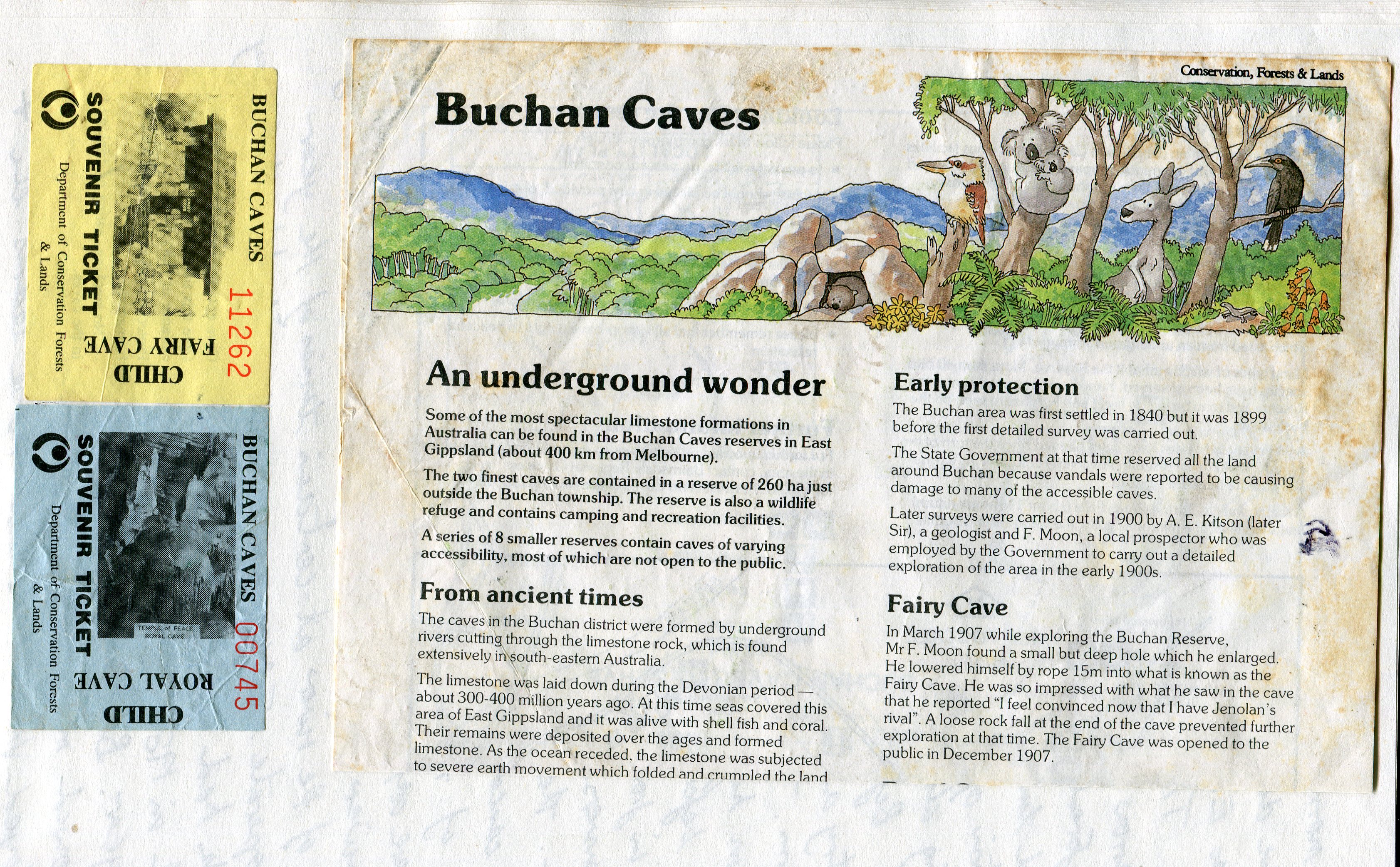
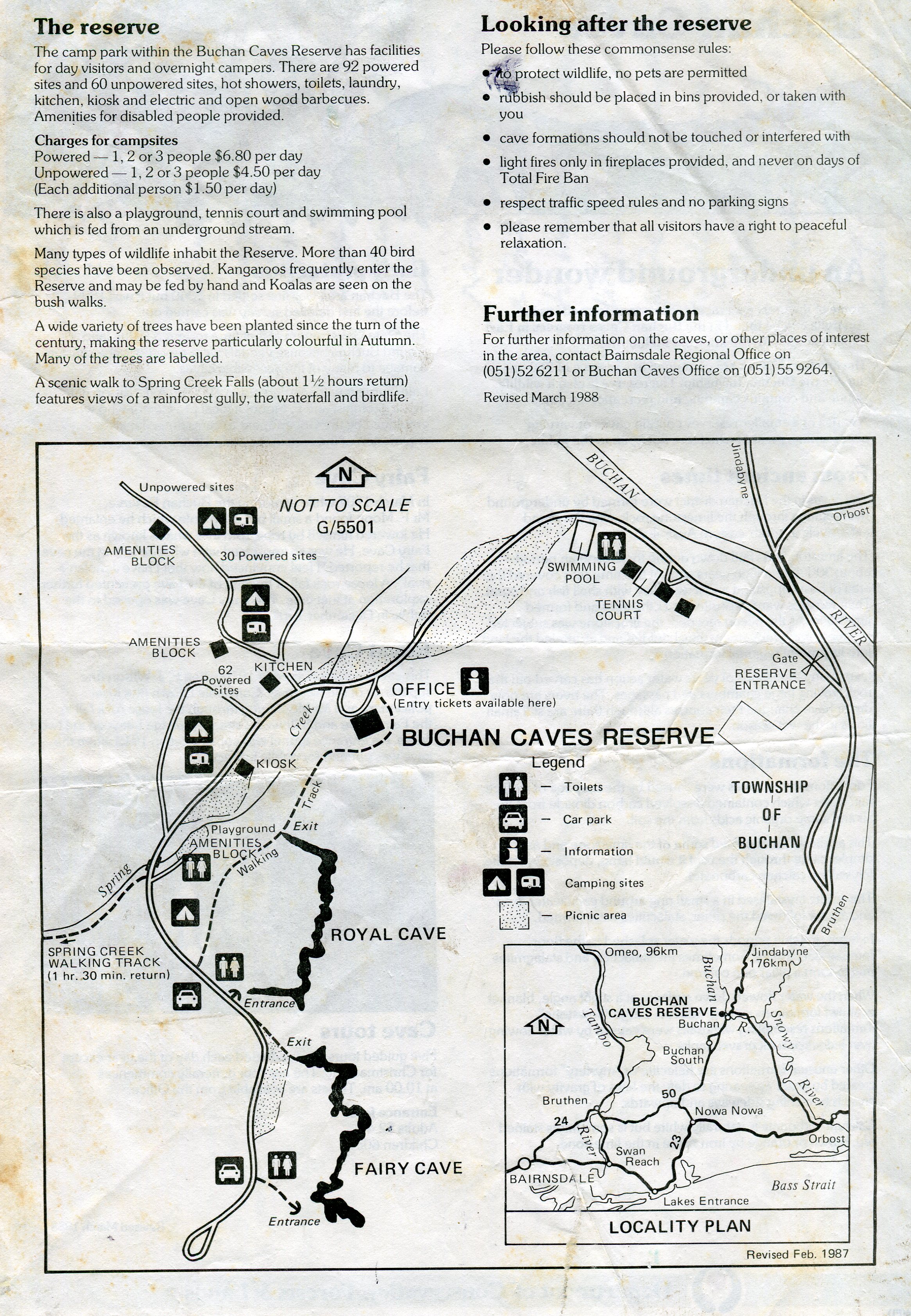
Lachlan, Anja and Rohan found the experience exciting as it was their first time in a cave. Lachlan had been to Jenolan Caves before but was too young to recall. The highlight, coming just before the end, when the guide switched off the lights. Ever since Rohan had been talking about a dark dark dark cave. Lachlan was intrigued by the guide’s description of fossils in the limestone and when we got over the shock of emerging from the 18 deg C, dull, moist cave into 30 deg C bright, dry, day we picked up a few samples of limestone containing fossils from the waterless creek bed.
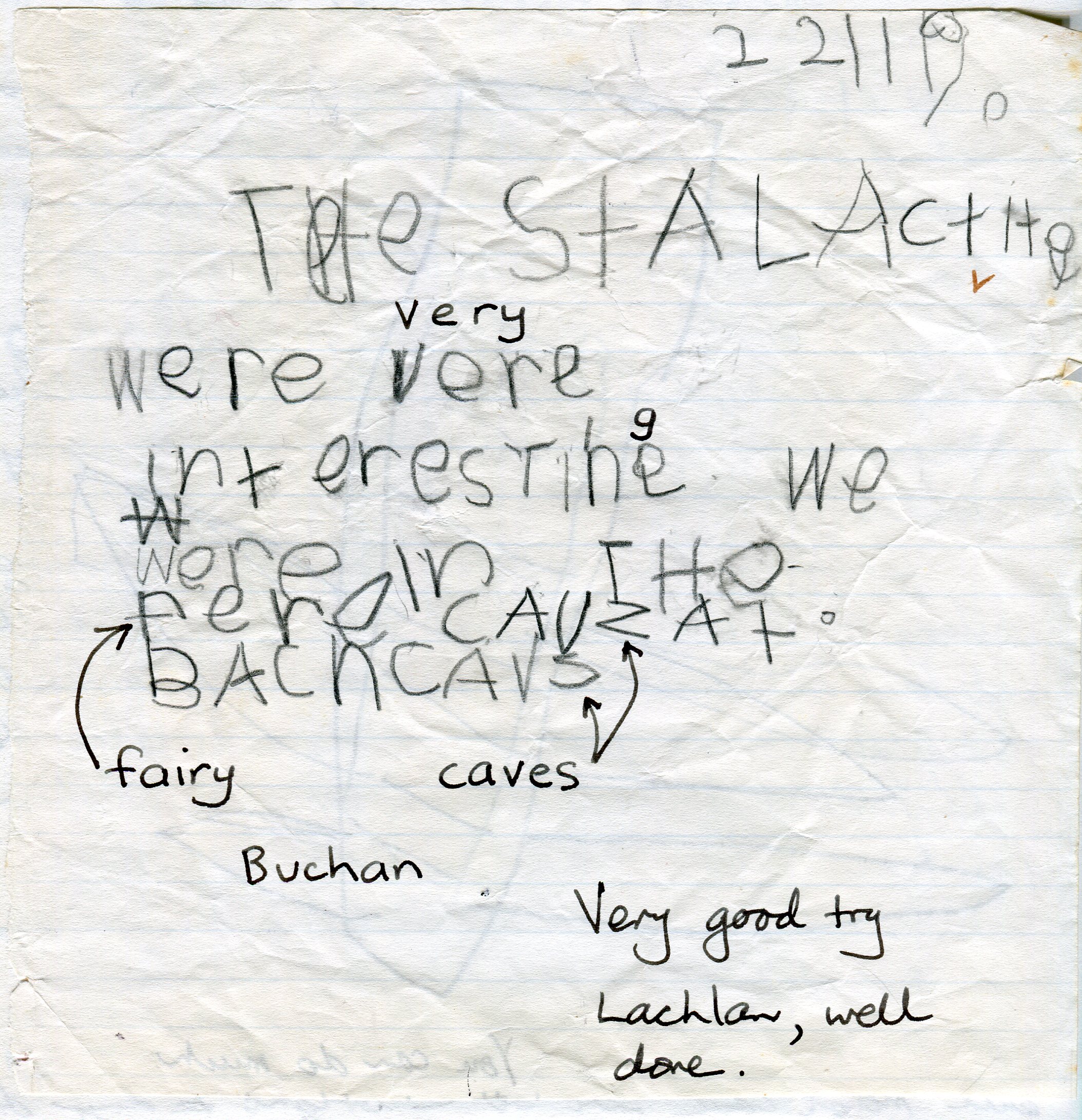
Lachlan's description of Buchan Caves
Onto Lakes Entrance where we chose a van park near the water and paid a premium price of $19.00 per day for the site. Never had we been so packed in with only enough room for the van and annex. Lakes Entrance is a tourist town and both Jacqui and I agreed that we should escape as soon as possible. During a short shopping trip into town we booked ourselves onto a 2 1/2-hour catamaran trip around the lakes.
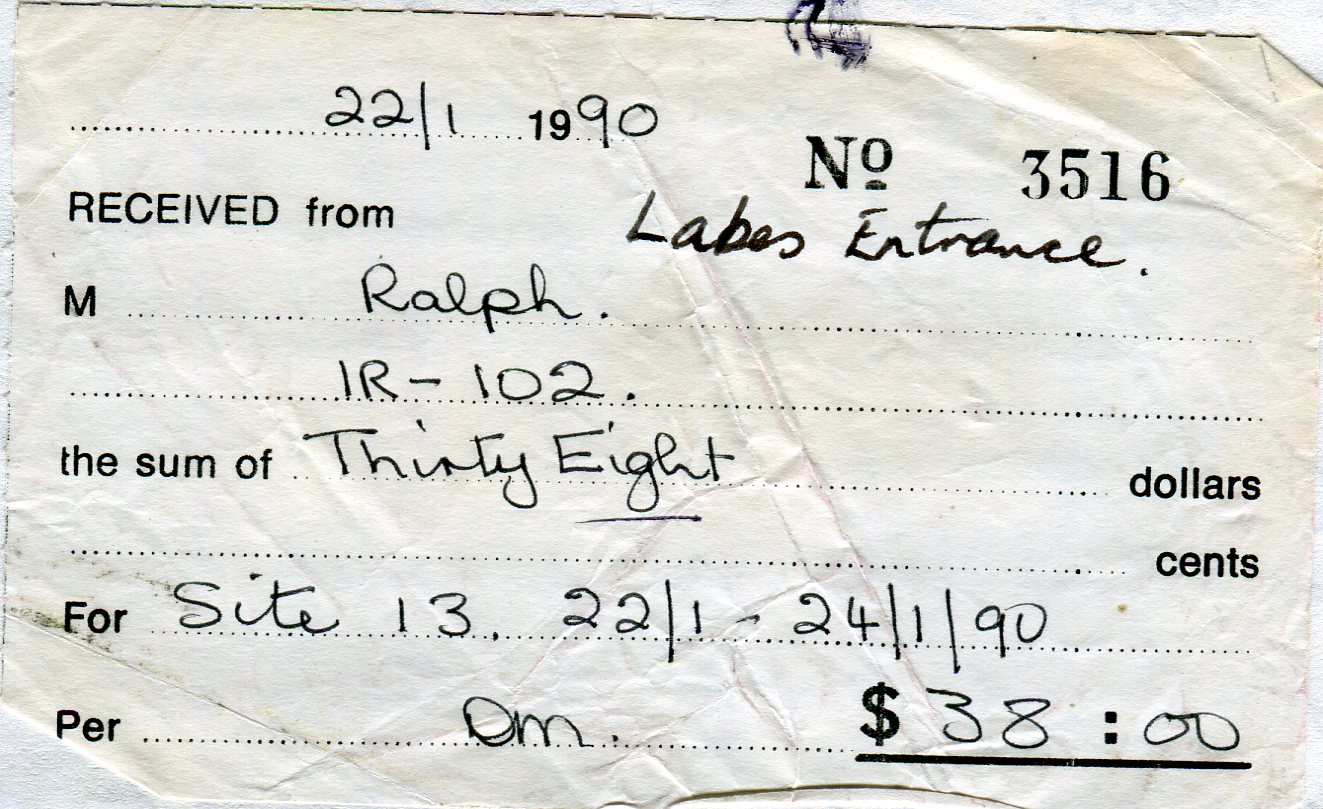
As we were tired, and it was late, we splurged on fish and chips. Flathead tales all round and chips for $5.75.
Links to other posts
In the beginning: Motivation and Planning
NSW: Merry Beach, Bournda State Recreation Area
Victoria Pt 1: Mallacoota - Lakes Entrance, Lakes Entrance - Melbourne
Tasmania: 1st - 18th February, 19th - 27th February
Victoria Pt 2: 28th February - 12th March
South Australia: 13th March - 27th March
Western Australia Pt 1: 28th March - 17th April
Western Australia Pt 2: 18th April - 5th May
Northern Territory: 6th May - 17th May
Queensland Pt1: 18th May - 31st May
Queensland Pt 2 to Sydney: 1st June - 20th June